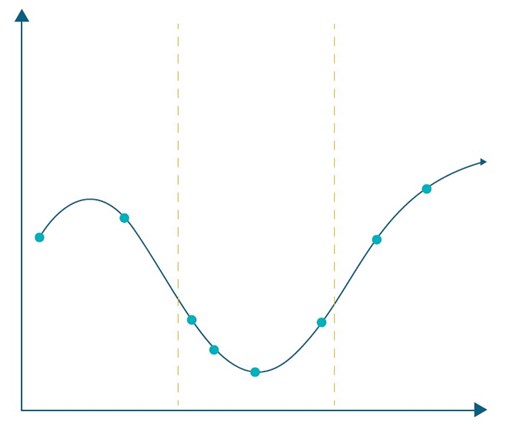By: Greg McKenna

May 31, 2022 — Governing is a journey that embraces change to seek a better way.
The most common word in political discourse is change. The power of change is present during every election season. The winning U.S. presidential campaign slogans1 from 1948 to 2020 show change as the prevailing, successful theme. Even today, leading studies from the Pew Research Center2 reveal that the majority of constituents across 17 advanced economies believe that their political system needs major changes or a complete reformation, with more than two thirds of the electorate holding this view in the U.S.
Given the importance of change in the public sector, it's worth taking a step back to consider the phenomenon of change itself. In particular, what effect does change have on the mindsets of the individuals who are in the midst of it?
The prevailing visual depiction of change is the Change Curve.3 It's a graph showing the rise and fall of emotion in response to changed circumstances over time. Researchers have identified a characteristic pattern of emotions that form in response to change. They point to an initial reaction of shock followed by the emotions of anger and annoyance as change sets in. These are unpleasant stages that can lead to decreased productivity, lack of motivation, and even forms of depression as the curve reaches its bottommost point.
But, then something special happens. The base of the Change Curve is called the inflection point. It points to the moment people begin to accept the idea that change is happening, let go of what was, and start to accept what can be.
It's no wonder that change is a compelling story in election campaigns. Change is the essence of every great narrative. In fact, commentators have mapped the Change Curve4 to the traditional story arc to show the direct relationship between embracing change and storytelling. Similarly to the Change Curve, the hero in every story overcomes startling obstacles, scales escalating conflicts, and navigates novel circumstances to rise successfully in the end.
In the public sector, constituents entrust elected and appointed officials to be the agents of change and to carry out the story of their administration. But, as we know, every superior outcome depends on quality processes and exceptional service delivery along the way. This is particularly true when the story involves helping injured workers back to wellness.
Earlier this year, during a virtual pre-bid conference call, a risk manager who oversees a metropolitan workers' compensation program impressed upon his audience the importance of effective change management when it comes to claims administration. As this public risk manager put it, implementation is not about transferring data or moving institutional know-how from one supplier to the next.
It's about ensuring the "continuity of care for our brothers and sisters who were injured on the job. Their lives and the well-being of their families are in your hands."
In this edition of Industry Insights, we take a closer look at the value of change and the important ways transitioning a claims program builds and protects the public trust. First, we address a framework for change management in claims administration. Then, we share communication methods that respect and dampen the Change Curve for stakeholders. Finally, we demonstrate how claim triage fundamentally assesses the program's health during change.
Empowering Change Management Through Dedicated Resourcing
Public agencies often appoint a chief transformation officer5 to drive accountability, meet deliverable milestones, and lend necessary resources to change management events. We've adopted a similar tactic through dedicated implementation teams who manage the key elements of casualty program transitions. These activities are firmly rooted in change management principles.6
An effective program transition begins with a kick-off meeting featuring trained implementation managers and claim ambassadors who engage with the administration's leadership to set bold, aspirational goals for the program. These goals become the "why" that will support the what, how, and when of change management. And, by setting these internal and external performance benchmarks, the two organizations begin to think as one as they move beyond the current state.
Next comes implementation, which is comprised of a balanced portfolio of pragmatic initiatives staged to carry out the shared program goals in order. This takes the form of detailed implementation playbooks, Gantt-style schedules, and organized thinking to achieve the transition objectives. The process of Implementation analyzes the steps necessary to achieve the change management goals and defines the time frames and resources. These features, when followed, will lead us to the pre-established outcomes.
To this end, change management requires execution.7 We advocate that leaders from both the agency and the claims administrator set regularly scheduled meetings to affirm performance. Best practices for these meetings include predictable scheduling, detailed agenda-setting, accurate capturing of open items, and assignment of responsibility for deliverables. This level of discipline fosters the kind of accountability that drives change. What's more, these meetings also allow us to engage in conversations that go beyond the tactical agenda, and when needed, run through problems. To ensure quality improvement, we employ a Net Promoter Score and survey feedback loop with our new clients. These tools enable continuous improvement in our change management processes.
Communication Flattens the Change Curve
Communication is most effective when it is audience-centric and resonates with the emotional state of its recipients. Ordinarily, it's hard to predict the emotional state of a reader. But when it comes to communicating around change management, the Change Curve once again provides a vital road map toward the mindsets of the individuals who are experiencing change. Communication experts point to the best way to move readers toward a successful new beginning by using the four Ps of change communications.8 We use these concepts in our multichannel communications campaign that coincides with stakeholders' needs for information and respects their journey through the Change Curve.
The campaign consists of multiple forms of communications, such as flyers, posters, email blasts, and intranet pages. The primary communication goal is to explain the purpose of the change by featuring the shared aspirational goals for the program. Next, the communication campaign paints a picture of the destination, including the look and feel of our shared goal. Based on the milestones in our transition playbook, the next wave of communications describes the work plan that tells people how we will get from point A to point B. And, finally, and perhaps most importantly, the campaign invites stakeholders to take part in the process to make the change a success.

Triage Leads the Way
As our public risk manager colleague implored above, transitioning a casualty claims program is an exercise in "continuity of care." The phrase itself evokes the concept of the patient severity scoring9 used in emergency rooms, where experts across health care disciplines receive patients by immediately reviewing vital signs, assessing the functionality of the patients' systems, and staging those cases most in need of urgent care.
Transitioning an open inventory of casualty claims requires a triage process that is equally scientific. In truth, robust triage not only protects injured workers but also empowers the new claims adjusters to receive claims in a strategic, orderly manner. To support these initiatives, sophisticated claims operations employ a predictive model to score pending claims on their complexity and severity. This level of scientific triage applies an objective set of criteria to identify and validate the most pressing claims and stage their transition. When done effectively, the triage process results in a full inspection of the claims inventory, including the attendant ancillary systems. This transparency allows for an invaluable health assessment and sets the course for the program's new horizon.
Throughout 2022, we're exploring the innovative ways the public sector leverages partnerships in claims administration. In this edition, we looked at the role of change in the public sector and the ways an effective change management framework, a cohesive communication campaign, and a scientific triage process can help your administration embrace change and seek a better way forward.
Thank you for your support, readership, and valuable feedback on our Industry Insights series. We love hearing from you.
Author

Greg McKenna
Sources
1The winning slogan from every U.S. presidential campaign since 1948
2Citizens in advanced economies want significant changes to their political systems
3How to apply the Kübler-Ross Change Curve in the workplace
4The Kübler-Ross Change Curve for story
5America 2021: Making change happen against the odds
6Better and faster: Organization agility for the public sector
7Take charge — without taking over
Make Gallagher Bassett your dependable partner
When making the right decision at the right time is critical to minimize risk for your business, count on Gallagher Bassett's extensive experience and global network to deliver.

